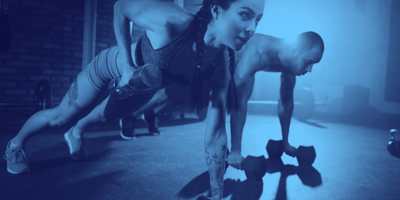Chronic pain can affect anyone, especially active adults who participate in sports or regular...
Shoulder Health 101 for Overhead Athletes
Learn shoulder care and injury prevention tips
Shoulder Anatomy basics
Despite how common shoulder pain can be, understanding shoulder anatomy and function can be daunting. For example, the shoulder is actually a complex that contains four different joints. These joints have a network of tendons and ligaments that connect the muscle to bone so we can lift a barbell overhead or play catch with our kids. It's pretty amazing we can move our shoulder in a 360 degree range of motion to be able to really control and thrive in our environment.

In physical therapy we often see pain in the shoulder, commonly at night or after hard bouts of activity or exercise. The biggest culprit we seem to find in shoulder pain is rotator cuff tendinopathy. The rotator cuff is made up of four different muscle that stabilize the shoulder. When these are weak or hurting they can get thin and frayed leading to a tendinopathy. That basically means that tendon that attaches the muscle to bone is under too much stress and can cause pain, inflammation, and weakness. Tendinopathy, if left untreated, can lead to rotator cuff tears which cause more pain and weakness that can lead to surgery.

That is why at Elevation Athletics we believe that understanding the anatomy and function of the rotator cuff is essential for maintaining shoulder health and preventing injuries in the future.
Preventative Measures and Exercises to Strengthen the Rotator Cuff
There are several preventative measures and exercises that we like to give our clients here at Elevation Athletics to strengthen the rotator cuff. We also make sure mobility is there in the shoulder to make these exercises as effective as possible. Lets go through some of our favorite exercises with our staff.
- Banded shoulder Opener- The shoulders can often be stiff with overhead motions, this can cause shearing and pinching in the front of the shoulder with repetitive use or added resistance. This banded stretch is a great way to increase mobility overhead to allow for smoother motion
- Sidelying shoulder External Rotation- This is our favorite isolated rotator cuff exercise to really target that rotator cuff. Make sure when you're doing this exercise the rotation is coming from the shoulder and the body stay stills. Keeping the elbow glued to the side is game changer. Grab a lighter weight and perform for higher reps to work those stabilizers
- Kneeling Windmills- Lastly the rotator cuff is a stabilizer so this is our favorite overhead stability exercise! Think about rotating the shoulder blade on the ribcage to maintain stability here. A kettlebell will be more challenging than a dumbbell but use whatever you have access to!
The Benefit of Performance Physical Therapy and Shoulder pain
If you are having consistent shoulder pain you could greatly benefit from physical therapy services. My greatest advice to anyone is do not wait for things to get worse. Everyone thinks the shoulder can get better over time, but without proper rehab you could be putting yourself at risk for a rotator cuff tear. Here at Elevation we take each and every client through a physical exam and dive into the shoulder. We are looking for deficits in mobility, strength, and coordination of the shoulder complex to help you move your best. We then will take the exam findings and recommend a personalized program to best fit your needs and goals. With proper care and maintenance of the shoulder muscles, one can decrease the chance of rotator cuff injuries and surgery in the future.
Come see us, we are here to help!
%20(1).png?width=500&height=128&name=Elevation%20Atletics%20(3)%20(1).png)


